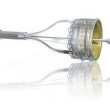Even though the incidence of complications in transcatheter aortic valve replacement (TAVR) have significantly decreased, there is one in particular that remains a concern since, when mild, it is associated to increased events rate. This complication is prosthetic paravalvular leak , which happens between the native annulus and the stent. The Lotus valve, completely repositionable, uses a...
TAVI in Horizontal Aorta: Neo2 vs. Sapien Ultra
There are controversies regarding transcatheter aortic valve implantation (TAVI) in cases of challenging anatomical complexity, such as horizontal aorta (HA). This is primarily because aortic angulation (AA) impacts the procedure differently depending on the valve type used. As previously studied, angulation complicates crossing, implantation, and coaxial positioning with commissural alignment. In the study presented by...
Third Generation Balloon-Expandable and Self-Expanding Valves: TAVR Meta- Analysis
TAVR’s significant advance has driven the development of valve technology, which is currently in its third generation. Even though outcomes have improved, randomized studies are yet to compared balloon-expandable (BEV) vs self-expanding (SEV) valves in randomized studies, and we only have information from different analysis with contradicting conclusions. This was a meta-analysis of 16 studies...
EuroPCR 2024 | NOTION-2: TAVI vs SAVR, Randomized Study on Low-Risk Young Patients with Severe Tricuspid Disease or Bicuspid Stenosis
Many of the studies comparing TAVR against SAVR in low risk patients included patients between 70-75 years, excluding those with tricuspid valves. This study included low surgical risk patients with severe aortic stenosis and symptoms, 75 years or younger. Participants were randomized 1:1 to receiving TAVR or SAVR, stratified according to sex, need for new...
EuroPCR 2024 | SOLVE-TAVI: Self Expanding or Balloon Expandable Valves?
This was a randomized study with 447 patients carried out to compare the 5-year evolution of TAVR using Evolut R and SAPIEN 3, as well as general anesthesia vs. conscious sedation. Randomization was in two stages: first valve selection and later the anesthesia technique, that is, conscious sedation vs general anesthesia. The populations were similar....
TAVR in Bicuspid Valves
Bicuspid aortic valve (BAV) disease affects 1%-2% of the population and manifests with severe aortic stenosis in the middle-aged. It characterizes for a very different anatomy with more calcification than the tricuspid aortic valve. At present, surgical aortic valve replacement (SAVR) is the first treatment indication. TAVR in this scenario has shown, in different studies,...
Short-Term Outcomes of TAVR in Asymptomatic or Minimally Symptomatic Patients
Aortic valve replacement (AVR) is indicated for symptomatic aortic stenosis (AS), while close follow-up is recommended for asymptomatic patients, unless they have elevated aortic gradients, low ejection fraction, or abnormal stress tests. However, the optimal timing to perform AVR is uncertain, especially with recent evidence suggesting that patients with AS associated with signs of myocardial...
TAVR in Low Risk Patients: 10 Year Evolution
The Treatment of severe aortic stenosis has experienced a significant revolution with TAVR, especially in high and intermediate risk patients, and it is now extending to low risk patients. In the US, nearly half of patients under 64 are being treated with TAVR. One of the fundamental questions that still remains unanswered revolves around device...
ACURATE Neo2: One-Year Hemodynamic and Clinical Benefit Results
Both Acurate Neo2 and its predecessor, Acurate Neo, have proven their safety and efficacy in the percutaneous treatment of severe aortic stenosis. The Acurate platform offers a lower gradient and a larger effective orifice area, as well as a low risk of periprocedural complications, according to previous registries. However, the first-generation Acurate device had some...
EVOQUE: Transcatheter Tricuspid Valve Replacement, One-Year Outcomes
Treating tricuspid regurgitation (TR) has gained increasing importance in interventionism. There is abundant literature on the negative natural evolution of this condition and its unfavorable prognosis, as well as the clinical challenges associated to optimal medical treatment. Among its percutaneous treatment options, both edge-to-edge repair devices (TEER), as showed in TriValve and TRILUMINATE trials, and...







